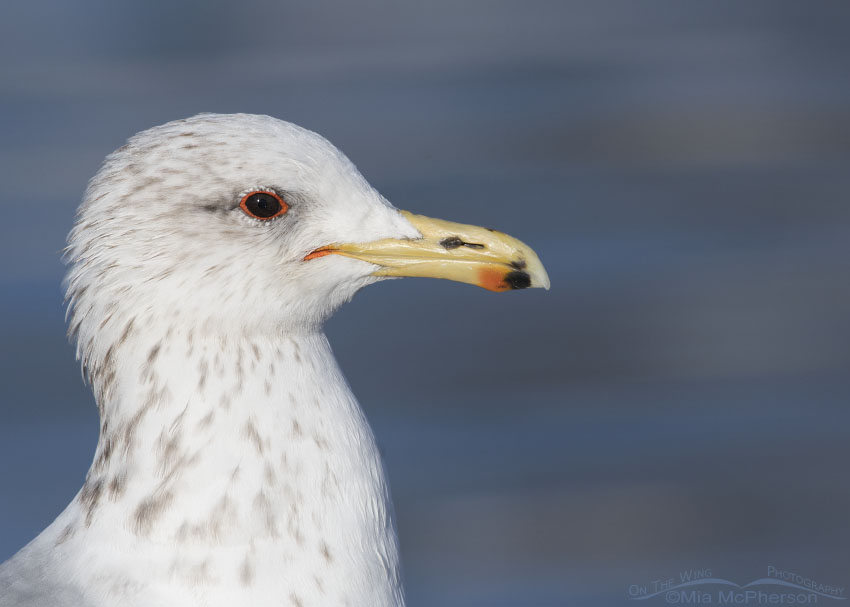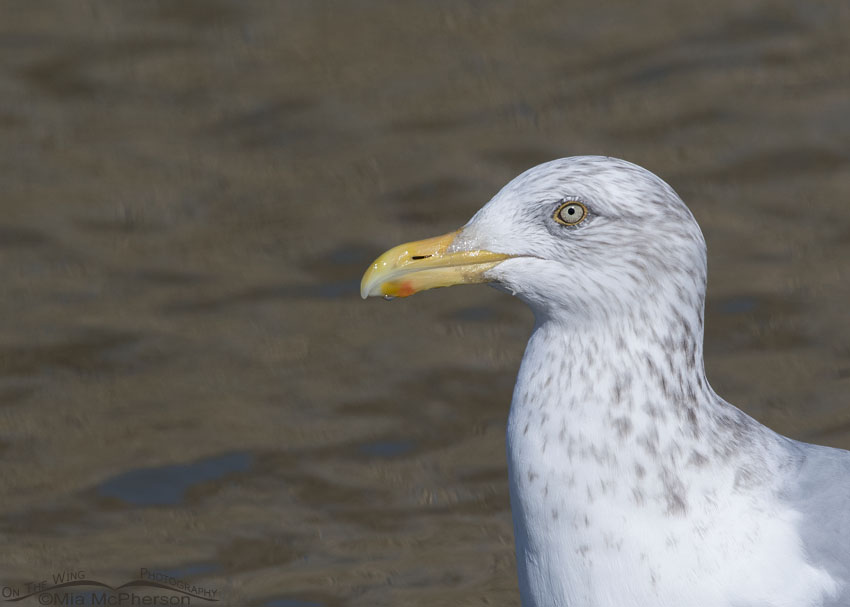 Winter California Gull profile portrait – Nikon D500, f7.1, 1/2500, ISO 500, +0.3 EV, Nikkor 500mm VR with 1.4x TC, natural light
Winter California Gull profile portrait – Nikon D500, f7.1, 1/2500, ISO 500, +0.3 EV, Nikkor 500mm VR with 1.4x TC, natural light
A few days ago I was able to take a few close up images of Herring Gulls at Farmington Bay WMA as they fed on dead carp at the four way area along with some Ring-billed and California Gulls. We have the Ring-billed and California Gulls in northern Utah year round but the Herring Gulls are only winter visitors to this area. With these two profile portraits I can point out some of the differences in the orbital rings, gapes, gonydeal spots and iris color to help with identification of these two species here in northern Utah.
The California Gull above has a red orbital ring, an orange gape that will become redder in breeding plumage, large black and red gonydeal spots on the bill and and a dark iris. I photographed this gull in January in Salt Lake County, most of the the adult California Gulls I am seeing now are going into or have already molted into their breeding plumage.
The nasal opening of this gull’s bill has a glob of something on it that would not normally be there.
Note: California Gulls can occasionally have light colored irises so it is best to look at a combination of these features rather than just a single feature.
 Winter Herring Gull profile portrait – Nikon D500, f9, 1/2000, ISO 400, +0.3 EV, Nikkor 500mm VR with 1.4x TC, natural light
Winter Herring Gull profile portrait – Nikon D500, f9, 1/2000, ISO 400, +0.3 EV, Nikkor 500mm VR with 1.4x TC, natural light
I photographed this Herring Gull the last day of February at Farmington Bay WMA. This Herring Gull has a yellow orbital ring, a yellow gape, a red gonydeal spot with just a smudge of a black spot and a light colored iris.
Note: Herring Gulls can also have a small black gonydeal spot along with the red spot so it is best to look at a combination of these features rather than just a single feature.
At first glance these portraits of the two gulls may look very similar but by looking at gapes, gonydeal spots, iris color, and the orbital rings around the eyes the differences in those ID features between these two species stand out well for me.
There are other differences between these two species including mantle color, size, bill size, weight, leg color, sub-terminal spots on their primaries and more. The larger species of gulls can take up to four years to obtain their adult plumage which makes ID and aging challenging.
Some people see a gull and just think they are trash birds, me, I’m always happy to see and photograph gulls when I can, especially the gulls I only see for a short period of time during the winter.
Life is good.
Mia
Click here to see more of my California Gull photos plus facts and information about this species. To view more of my Herring Gull photos plus facts and information about this species click here.
I saw on Facebook where another photographer photographed a Franklin’s Gull at the WMA the same day I photographed this Herring Gull at Farmington Bay which is a bit early for Franklin’s Gulls, they typically start showing up in numbers towards the end of March and early April. I am anxious to see them again.


Such vivid and beautiful eyes. Without your images we would never see such beauty in such detail. Thanks Mia.
Glorious portraits of a sadly maligned species.
Very nice photos and lesson I will share with my daughter, we were just having a “gull conversation”.
Thank you for the lesson one the difference between the California Gull and the Herring Gull. Except for gulls that have very distinctive features (eg, Ring-billed, Black-backed, Bonaparte’s, etc) I find gulls so very confusing. Gorgeous portraits, by the way.
Nice